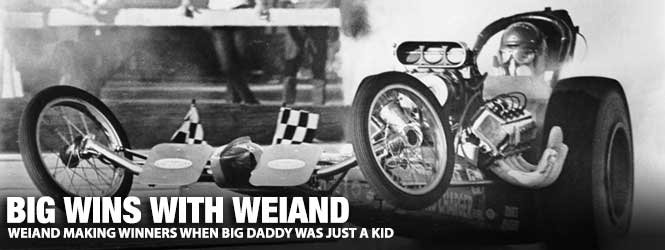
For the last half of the 20th century, Tampa, Florida’s “Big Daddy” Don Garlits was the name associated with drag racing. The celebration of the National Hot Rod Association’s (NHRA) first 50 years resulted in a countdown of the top 50 drivers, and Garlits finished as the #1 driver. Garlits won his first NHRA event in 1955; three years later, he moved to professional status, and the rest is history.
His on-track accomplishments include piloting the first dragster to top 170, 180, 200, 240, 250, 260, and 270 MPH, and he was the first to 200 MPH in the 1/8 mile. Over his four decades of racing, he earned 17 World Championship titles (10 American Hot Rod Association, four International Hot Rod Association, and three NHRA), eight prestigious U.S. Nationals Eliminators, and a total of 144 National Event wins.
Above Left: “Big Daddy” Don Garlits ran Weiand components on his early Swamp Rat dragsters. This January 1961 Hot Rod Magazine ad asks its users to follow the champions, and Garlits was the champion. Above Right: A year earlier, the same dragster running injection ran over 180 mph.
However, he was much more than a driver. He was one of the sport’s greatest innovators, fabricators, and historians (he owns the Don Garlits Museum of Drag Racing in Ocala, Florida). With the assistance of numerous mechanical experts, he built 38 “Swamp Rat” (SR) dragsters (some with A, B, and C designations), starting with the first in 1956.
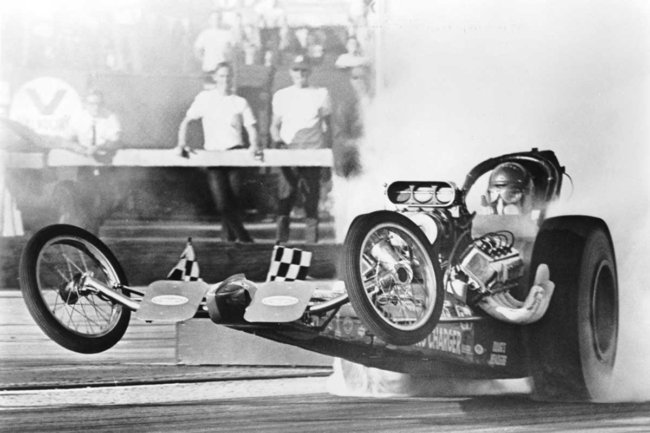
Above: There is nothing cooler than a front engine dragster smoking the tires while carrying the front tires. By the mid-1960s, Garlits had switched from the Gen I Hemis to the 426 Gen II.
Garlits started using Chrome Moly tubing in his Swamp Rat dragsters in 1959. He was also an innovator of streamliners (SR 17, 32, and 34), mono-wings (SR 32 and 34), sidewinder engine locations (SR 27), turbine engines (SR 28), and more recently, he has set records with two electric-powered dragsters, but his greatest accomplishment was the development of the rear engine dragster (RED).
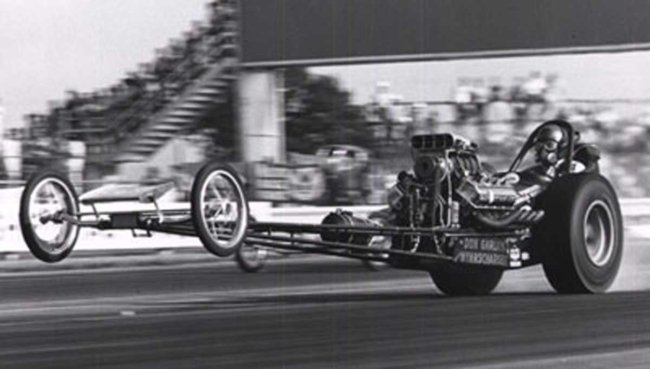
Above: Garlits Swamp Rat 13 in its normal stance off the starting line. Unfortunately, the wheel stands became excessive, and teams were forced to add more weight onto the front axle. Additional weight was not the best solution, but it kept the front tires closer to earth.
By the late 1960s, the front engine dragsters began having severe clutch-related failures. Then, in 1970 at Lions Dragstrip, Garlits suffered one of the worst clutch explosions when his Swamp Rat 13 was cut in half after his experimental transmission and clutch let loose just off the starting line. The resultant debris cut off the end of his right foot. While recovering from his injury in the hospital, he sketched a RED design, which became SR 14.
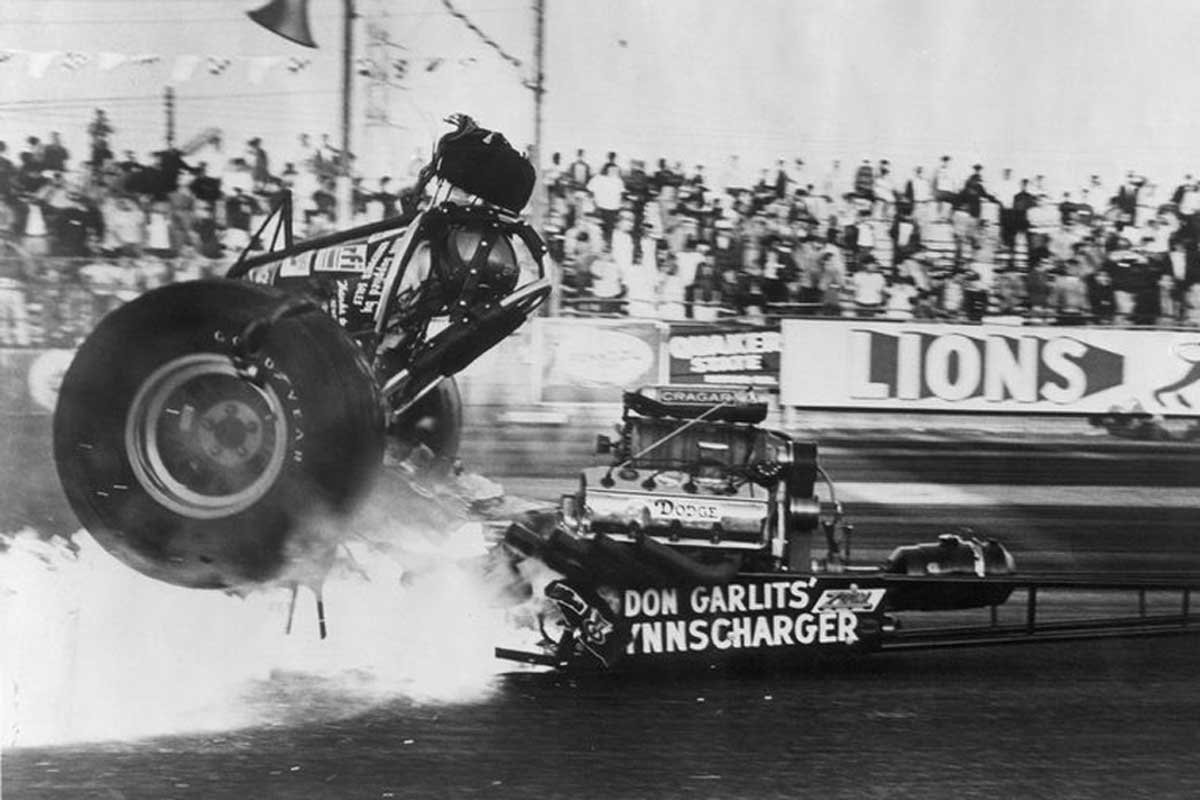
Above: Clutch explosions became a common occurrence in Top Fuel in the late-1960s. Garlits’ two-speed Garlits-drive transmission failed in 1970. The clutch and transmission debris cut the chassis in half, and at the same time, severed the end of his right foot.
At first, the rear engine dragster was not successful, and Garlits built a front engine dragster, SR 15. His wife, Pat, stepped in and told him to figure out the rear engine dragster. After working out the kinks and slowing down the steering ratio, the rear engine dragster was immensely successful and permanently changed the Top Fuel class.
Above Left: While in the hospital, Garlits drew an example of a rear-engine dragster. Once back home, Garlits, with assistance, welded up Swamp Rat 14. After a sharp learning curve, the dragster was a great success and changed the landscape of Top Fuel. Above Right: Swamp Rat 27 was an experimental dragster. Garlits was interested in positioning the engine in a transverse location in the chassis. After some testing, no gearbox could successfully handle the engine torque. The testing proved the longitudinal engine mounting was superior.
The rear engine dragster was safer, but its real success was a weight distribution that could plant the rear tires without the need for excessive amounts of front-end ballast to prevent wheel stands. For more information about the advantages of the RED, check out Randy Beikmann’s book Physics for Gearheads.
So impressive were the rear engine dragsters built by Garlits, Bill Pratt stated, “Garlits recorded perhaps the best run in drag racing history, his amazing 5.637-second, 250.69-mph blast at the 1975 World Finals.” The 5.63 was a tenth and a half quicker than the previous elapsed time mark, and it remained the class record for almost seven years.
Above Left: Ahead of his time, Garlits developed the first of several aero dragsters in the 1980s. Small front tires under an aero nose cone, a canopy, and moon discs kept Garlits on the cutting edge of the class. Above Right: After years out of the driver seat, Garlits, in his mid-80s, stepped back into the seat of a dragster. However, his last two dragsters have been electrically powered. Garlits set several mph records, but his electric dragsters came up short on eclipsing the 200 mph goal for the quarter-mile.
Over the years, for quarter-mile motivation, Garlits utilized flathead Ford engines, Buick Nailheads, and blown small-block Chevys until relying on an array of Gen I and II Hemis and Donovan 417 engines on either gasoline or nitromethane (the NHRA outlawed nitro in the late 50s into the early 60s). Early in his career, he used Weiand Power and Racing Equipment products as depicted in the 1961 Hot Rod Magazine ad. Garlits relied on Weiand to propel the supercharged SR 1-B to an 8.77et at 186 MPH while putting it in the winner’s circle.
Phil Weiand, born in Los Angeles, California, in 1913, became interested in vehicles at an early age. When he was 14, Weiand obtained a 1922 Model T Touring car. Eventually, Weiand was able to replace the Touring body with one from a Model T roadster. Based on his high school auto tech knowledge, he designed and built a downdraft carburetor intake, a custom header, and an exhaust for the car.
Above Left: Weiand has expanded its catalog with components to swamp Gen III Hemis into muscle car era rides. If the Hemi is a 2009 or newer, Weiand has a pan for the engine. Above Right: An earlier Gen III Hemi will require a different pan.
In the spring of 1933, Weiand took the seriously modified roadster to Muroc Dry lakes. At his first event, the Model T achieved 91.80 MPH. After replacing the Model T frame with a 1926 Chevy chassis, adding a Franklin front axle, and mounting a pair of Ed Winfield downdraft carburetors on his Weiand manifold, he increased his speed to over 116 MPH.
In 1934, an unsanctioned high-speed run scared his passenger, and as the car approached a curve in the road, the panicked passenger pulled the park brake handle. The result was the vehicle flipping over and ejecting Weiand from the car. At the age of 20, Weiand was paralyzed from the waist down.
Above Left: Weiand has dual-plane intake manifolds in square- or spread-bore designs for the old school engines. Above Right: If more air and fuel are needed, a dual carb tunnel ram from Weiand will fit the bill.
With time on his hands and a loss of direction for his life, Weiand decided to satisfy his interests and develop an intake manifold inspired by the Jack Henry two-carburetor layout. With his manifold designed, he borrowed $250 from his mother and had ten intake manifolds cast, which were dubbed the Weiand High Rise. He installed one on his flathead and sold the other nine to various racers.
Weiand began selling his products through Karl Orr’s speed shop, Bell Auto Parts, and other speed parts retailers of the day. Except for the WWII years, Weiand’s business continued to grow. After the war, Weiand introduced aluminum 3×2 and two-four-barrel manifolds and aluminum heads for flathead Fords.
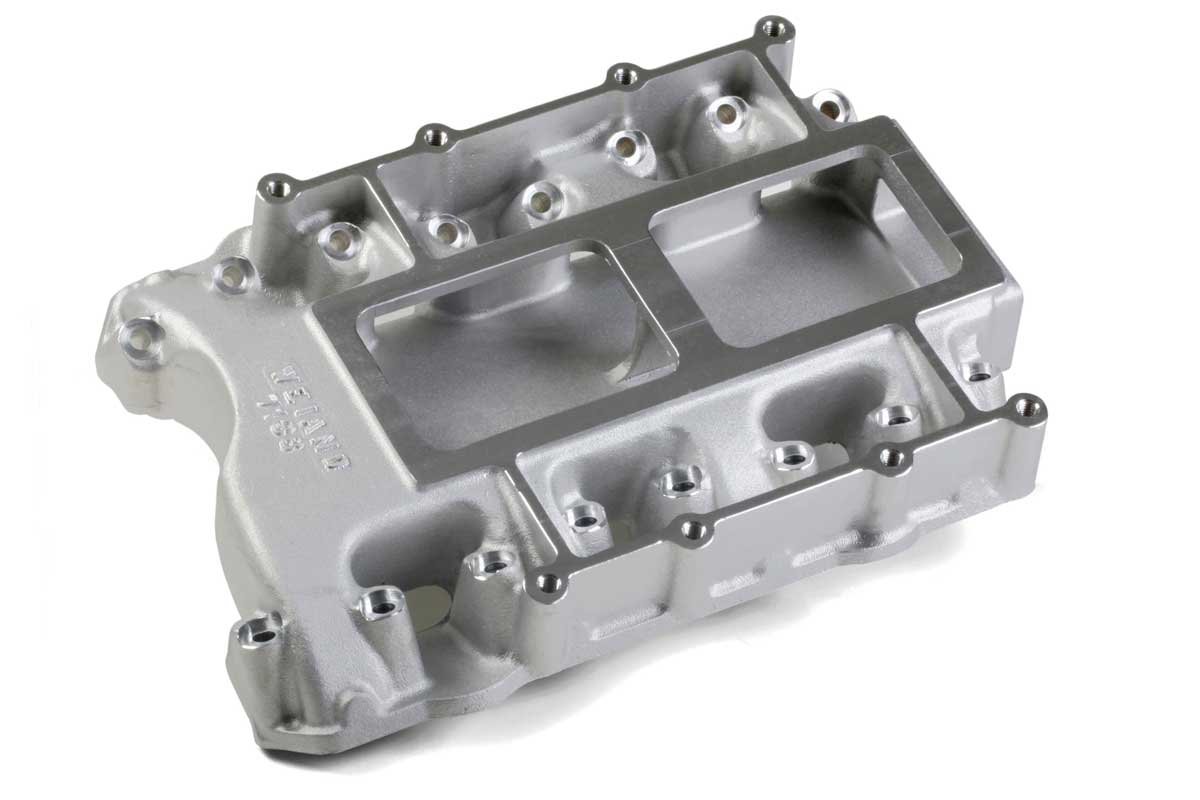
Above: Weiand has blower manifolds for 392 Hemis. With this manifold, the Hemi can be set up with a blower similar to what Garlits used in 1961.
By the 1950s, Weiand developed the Drag Star log-style manifolds for Hemis and expanded into supercharger drive gears based upon the GMC 6-71 blowers. At the end of the decade, Weiand purchased a foundry, which grew the business because he had total control of the casting of his products.
It was during this time the Weiand “Say WHY-AND” slogan began. The new products continued in the 1960s with the Colt, an aluminum 180° dual-plane manifold and the Hi-Ram manifold with D-port runner technology.
Above: For proper routing of the upper radiator hose, Weiand has several water outlet designs to fit any imaginable angle necessary.
During the 1970s, Weiand launched the X-terminator single plane manifold series, aluminum water pumps, the X-CELerator single plane intake series, and the 360° Team G manifolds. Sadly, in 1978, Phil Weiand passed. Rather than sell the business, his wife, Joan, continued to run the business and introduce additional products.
Joan sold Weiand to Holley Performance in 1998. Since then, Holley’s involvement has moved Weiand into the 21st century with software-developed intake manifolds, oil pans, superchargers, water pumps, and water outlets. If performance is desired, getting more air into the engine is necessary. Weiand is the answer for increased airflow for modern engines just like it was for Big Daddy back in 1961.













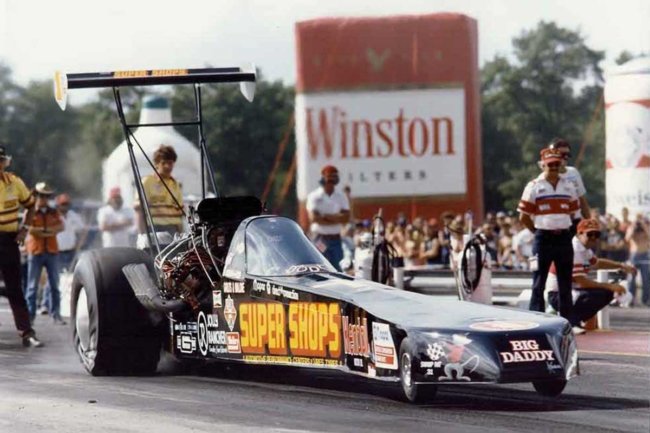
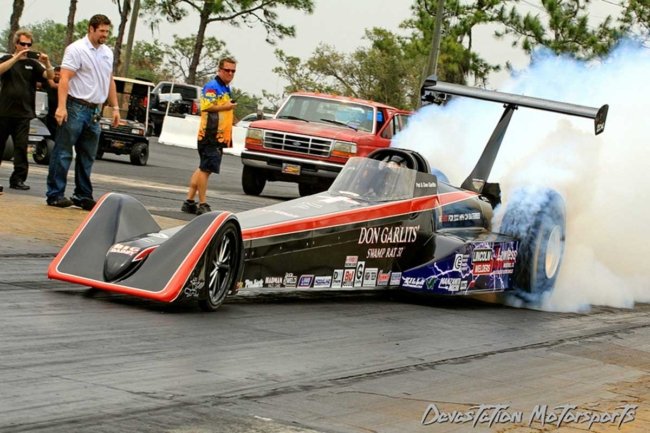
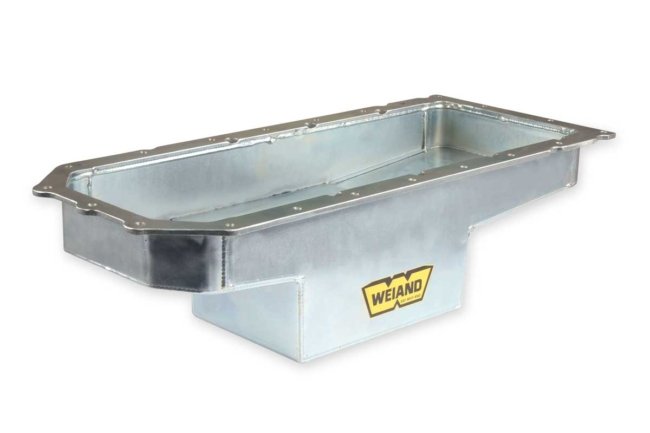


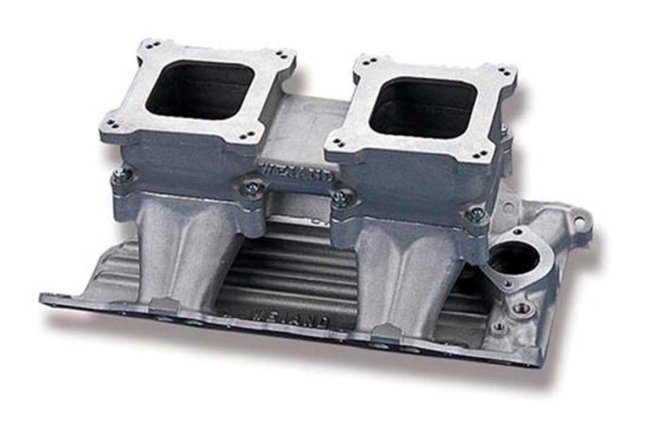
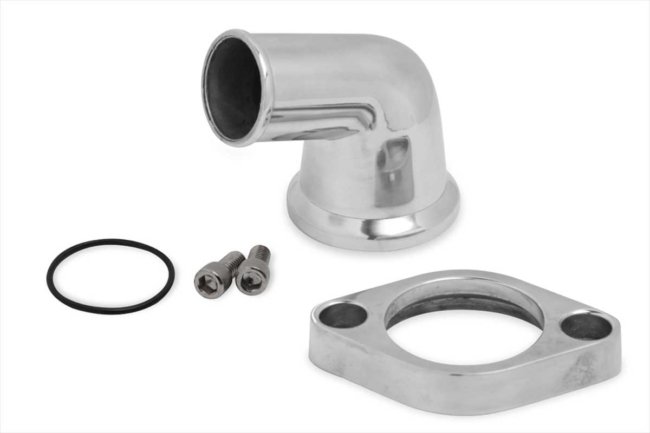


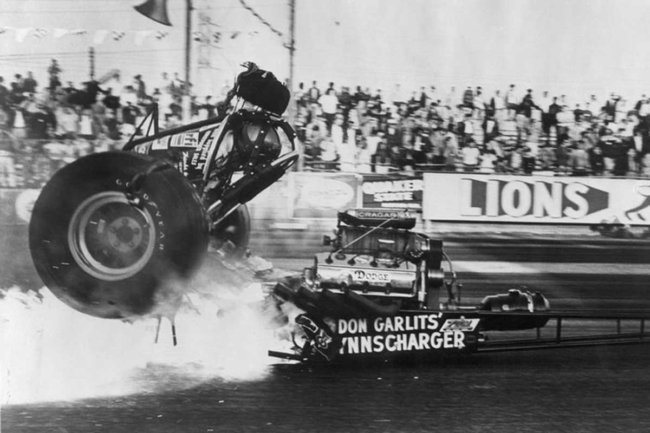





 Mopar Connection Magazine – The ONLY Daily Mopar Magazine © 2022. All Rights Reserved. Mopar Connection Magazine is the ONLY daily Mopar Magazine bringing you the latest Mopar news, technology, breaking news, and Mopar related events and articles. Find out the latest information about Mopar, Mopar products and services, stay up to date on Mopar enthusiast news, dealership information and the latest Mopar social media buzz! Sign up for the Mopar Connection Magazine newsletter for the latest information about new products, services and industry chatter. Mopar Connection Magazine is the best and only source you need to be a Mopar industry insider!
Mopar Connection Magazine – The ONLY Daily Mopar Magazine © 2022. All Rights Reserved. Mopar Connection Magazine is the ONLY daily Mopar Magazine bringing you the latest Mopar news, technology, breaking news, and Mopar related events and articles. Find out the latest information about Mopar, Mopar products and services, stay up to date on Mopar enthusiast news, dealership information and the latest Mopar social media buzz! Sign up for the Mopar Connection Magazine newsletter for the latest information about new products, services and industry chatter. Mopar Connection Magazine is the best and only source you need to be a Mopar industry insider! by
by